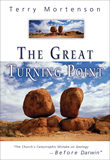Closing the Gap
Two centuries ago in an effort to explain “prehistoric” fossils, Christian leaders introduced the idea that a gap of time is missing between Genesis 1:1 and Genesis 1:2. This idea, which undermines the Bible’s integrity, is now making a comeback. It’s time to close this debate.
After a meeting in Coventry, England, during which I had criticized the gap theory, two ladies approached me at my book table. “There must be a gap between Genesis 1:1 and 1:2,” said one. So I went through a number of scriptures to show why the gap theory is untenable. They looked at me for a little while, and then asserted: “But there must be a gap there. Benny Hinn says so!”
Once largely dead in my home country, the United Kingdom, the gap theory appears to be undergoing a revival of interest. Yet many of its adherents are unaware that the theory has a name and was spawned by Christians of the nineteenth century who compromised with the false timescales proposed by early geologists.
Because of its continuing popularity, I think every believer needs to refresh his understanding of its teachings and be prepared to uphold the proper view.
A Brief Overview
Specifics vary, but gap theorists tend to believe the ideas listed below.
- A gap exists between Genesis 1:1 and Genesis 1:2. God made the world, and then something happened that caused it to “become” without form and void.
- The gap could be of very long duration—even millions of years.
- During this gap, so-called “prehistoric” creatures lived and died. Gap theorists believe that Lucifer was in charge of this “gap” world, but when he fell from grace (Isaiah 14; Ezekiel 28) God destroyed the gap world in a “Luciferian Flood.” After this, God “remade” the world in six literal 24-hour days, as outlined in Genesis 1.
Five Claims of Biblical Support
Gap theorists tend to cite these passages:
Genesis 1:2. “The earth was without form, and void.” It is suggested that the Hebrew word hâyâh (היה), translated “was,” could be translated as “became.” So the verse would read: “The earth became without form and void.”
Isaiah 14:12–21. This passage prophesies the fall of Babylon’s king. But since it refers to “Lucifer, son of the morning” in verse 14, it is often seen as a comparison to Satan’s fall. Gap theorists place this fall in the so-called gap between Genesis 1:1 and 1:2.
Ezekiel 28:11–19. This passage is a lament for Tyre’s prince, but many Christians believe it also compares the the prince’s fall to Satan’s fall and the Garden of Eden. Gap theorists suggest that the garden described in Ezekiel is different from the one described in Genesis 2. This, they say, was the original Luciferian Eden—a garden composed of minerals rather than plants.
Genesis 1:28. “God said unto them, . . . replenish the earth” (KJV). Gap theorists claim that the word replenish indicates that the earth must have been populated before Adam.
2 Peter 3:5–6. “By the word of God the heavens were of old, and the earth standing out of water and in the water, by which the world that then existed perished, being flooded with water.” It is claimed that Adam’s world was created out of the remnants of the Luciferian Flood.
Why the Gap Doesn’t Hold Water
The gap theory is not biblical and is, in fact, a compromise of the truth of Genesis.
Let’s examine these passages in reverse order.
2 Peter 3:5–6. Peter is criticizing uniformitarianism—the concept that the rate of geological change today has always been the same: “All things continue as they were from the beginning of creation.”
In opposing this view, Peter reminds his readers that scoffers deliberately ignore two events—the Creation and the Flood—which were unique in earth history.
Peter refers to this same Flood of Noah’s day in 1 Peter 3:20 and 2 Peter 2:4–5. In fact, there is no reference to a Luciferian Flood anywhere in Scripture.
Genesis 1:28. The problem is that the English language has changed since 1611. The KJV translators correctly rendered the Hebrew word as replenish, but it has changed meaning.
Replenish in 1611 did not carry any connotations of doing something “again”—that is not what the re- prefix meant in this context. It simply meant “to fill completely.” If the translation were done today, the word replenish would be incorrect. In fact, versions before the KJV—the Geneva and Tyndale Bibles—used the word fill. The New King James Version and other modern translations also use the word fill. Even the KJV translates the same Hebrew word as fill in Genesis 1:22. Isaiah 14 and Ezekiel 28. These passages describe the fall of real kings. Many creationists (though not all) also believe that each king’s fall is compared to Satan’s fall, but this does not require a gap. Satan could have fallen between Genesis 2 (day six of creation) and Genesis 3 (Adam’s fall).
This interpretation makes better biblical sense. Ezekiel 28:15 emphasizes that Satan (Lucifer) is a created being. Yet Genesis 1:31 claims, “Then God saw everything that He had made, and indeed it was very good.” So “everything” must include Satan.
Furthermore, there is no clear biblical basis for saying that Ezekiel 28 alludes to a garden different from the Garden of Eden. Satan could have visited this garden before he rebelled.
Genesis 1:2. Hebrew experts agree that the grammar of Genesis 1:1–3 does not allow for a gap. Notably, the Hebrew word rendered and at the beginning of verse 2 has a very specific meaning in this context. It introduces a parenthetical statement that breaks the sequence of events in verses 1 and 3.
A Hebrew reader would see this word and understand it to say, “Oh, by the way, before I tell you what happened next in verse 3, let me describe what the earth was like initially.”
The word and is a translation of the single Hebrew letter waw (ו). Whenever a sentence begins with the waw attached to a noun (as with “the earth” in verse 2), the statement is a parenthetical comment. It details the state of affairs at that point, not the next step in the flow of events.
Moreover, the Hebrew word hâyâh should not be translated “became” because this is not its primary meaning. A translator is not entitled to “expand the semantic field” unless the context requires a secondary meaning.
For non-Hebrew readers like me, there is another easy way to show that there cannot be a gap. Exodus 20:11 plainly says, “In six days the Lord made the heavens and the earth, the sea, and all that is in them.” So God made everything in six days, including things in the heavens.
Moreover, attributing the fossil layers to Lucifer’s Fall creates another problem. The fossil record is filled with signs of disease, thorns, and death. Yet God claimed that the world before Adam’s sin was “very good.”
This brief overview shows that the gap theory is not biblical. It is, in fact, a compromise of the truth of Genesis, which arose when Christian leaders tried to accommodate the millions of years claimed for fossil layers. The gap theory not only compromises the Bible but also fails to satisfy secular geologists, who no more accept a Luciferian Flood than the global Flood of Noah’s day.
Proverbs 30:6 warns, “Do not add to [God’s] words, lest He rebuke you, and you be found a liar.” As with so many errors, the gap theory arose when fallible, sinful humans tried to squeeze their ideas into the Bible. Instead we should start from the Bible and submit our views to His Word.
For more, see Weston Fields’s Unformed and Unfilled or Michael W. J. Phelan’s The Genesis “Gap Theory.”
Answers Magazine
October – December 2010
Human life is sacred, from fertilization until the day we die. This issue focuses on a creation-based understanding of the sanctity of life and mankind’s violation of the Creator’s clear directives.
Browse IssueRecommended Resources

Answers in Genesis is an apologetics ministry, dedicated to helping Christians defend their faith and proclaim the good news of Jesus Christ.
- Customer Service 800.778.3390
- Available Monday–Friday | 9 AM–5 PM ET
- © 2026 Answers in Genesis





